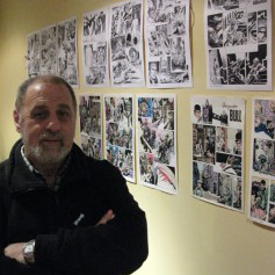
There are many ways art can be ranked on the “totem pole” of worthiness, and one of those ways—whether we like it or not—is whether the piece was made by hand, or by machine. This applies to crafts as much as to paintings; machine made goods are simply not valued as highly as those created by human hands. Almost always this ranking translates into higher prices for hand-made goods, but whether the amounts paid are higher or not, it is almost universally true that in first world countries* it is that which is hand-made that gets the most respect and is valued most highly.

(*I am qualifying this statement this way because historically just the reverse has been true for underdeveloped/3rd world countries, where it is the machine-made item that is rare, and therefore, prized. I don’t want to turn this posting into an anthropological analysis of consumer behavior. So—When I speak of what is valued most highly I am talking about the society/culture that you, readers and I—share. One in which both types of goods are equally available.)
There are many readers of this post whom I’m sure will have no issue when (for example) I compare a machine knitted sweater and a hand-knitted sweater. Even if they are made with the same yarn, and last as long, you’ll tell me that there’s just something about a sweater knitted with needles “by hand” and not a knitting machine, that makes them superior. I’m not sure about this, any more than I am sure, exactly, what “hand made” means when it’s HANDS that are holding the tool that is allowing you to create the final product.
The Task at Hand Matters

You might say, as a rule of thumb, that if it’s a repetitive task that will be performed exactly the same and with consistent material inputs then machining is better. Building cars on an assembly line, would be one example. Cutting material to make hundreds of dresses all of which conform to the same size patterns are another example. Assembly lines are good for some things, but not for others For jobs where attention to detail is critical and no two pieces are (or should be) exactly the same, meaning minor but critical adjustments need to be made at each step, then hand made methods are better. A “be-spoke” (hand tailored) suit or hand-blown wine glass are examples of that.

In our field of collecting, the major issue right now happens to involve the comparison of the product of digital art (digital media) to those of paintings (traditional media). Indeed, there are many artists who would claim that digital/computer art is every bit as ‘hand made’ as that of oil paintings. And that the computer is just a ‘tool’—just as a airbrush is a ‘tool’. I don’t know if this is true or not, and I am not here to argue that point. All I can tell you is that the jury is still out on this one….but many observers are having a hard time reconciling the differences.
Arnie Fenner, for example, who kindly supplied the foreword for my collection of essays dealing with the topic “Paint or Pixel: The Digital Divide in Illustration Art,” which included the views of 45+ artists, collectors, publishers and scholars (NonStop Press, 2007), had this to say:
“As nice as they are these days, as true as the color or as interesting the materials they’re out-put on (canvas or vinyl or paper) . . . prints are always just prints. It can always be replicated right down to the last pixel: even if there is only a single print, there is always the feeling that another (or another or another) could be generated as easily as pushing a button on a keyboard…The joy of viewing an original painting in a gallery or museum—or of owning one yourself—is the understanding that you’re looking at something extraordinary, observing a one-of-a-kind work that was created by hand that can’t be experienced in any other way, reveling and sharing in the artist’s exhuberance and vitality. It’s a covenant you’ve entered into with the artist, a personal connection that isn’t possible with either printed or computer generated art.”
While it’s entirely possible that Arnie has changed his mind since then, as we all evolve in our views over time, his thoughts encapsulate the general view today. Changes in collectors’ attitudes take time.
It’s an Option
For many artists and crafters, the choice of “machine” or “hands” (or partly hand, partly machine) are options. Sculptors working in stone can use electric drills, or hammers and chisel. Like many things in life, the choice whether to work in traditional media or digital media for (so-called) fine artists, or gallery artists, is an option, a “preference” if you will. For the overwhelming majority of commercial artists, those who historically have produced the kind of art I collect, and buy and sell as a dealer—SF/F illustration—it is not a preference, or an option. In order to get hired for a job, they have to be willing and able to create images as desired by the client. In other words, they must have the “skill sets” required to complete the assignment satisfactorily. And today, that means knowing how to use digital applications, tools, programs, etc expertly—whether to create wholly new images, or manipulate existing images in order to create new works.
MIND YOU, this has nothing to do with how the final product looks. These are two different mediums, but they are both able to create the same products! An artist who knows their way around digital media can create a work of art that looks like a beautiful watercolor painting. And conversely, an artist adept in traditional media can paint so that it looks as slick, clean and colorful as a digital work—like a photograph in its realism, for example.
Subjective Benefit
A great deal of this, i.e., our ranking of “handmade” as superior to “machine made” is “subjective”. The perception of handmade is that it is of a higher quality, whether that is true or not. There’s not much incentive for producing handmade items in quantify, and restricted supply combined with lack of competition in niche markets, and higher prices for such objects, is a signal to consumers that indicates quality. This is enhanced by artisans and artists putting their unique signature somewhere on the piece. In our field there’s also this:
1. Nostalgia: in an age noted for the speed with which new media and technology is forcing a “too” rapid adaption to change—it’s easy for us to wax nostalgic for times gone by. A simpler time (the past is always viewed as simpler) when cameras required film (and darkrooms where humans manipulated the film), when guitars were made one-at-a-time (not cranked out by factories), when tool boxes carried dozens of screwdrivers and not drill bits (fitted into electric drills). Nostalgia drives a huge swath of the market for illustration and comic art. The books and comics you read as a child, the TV shows you watched, the games you played, it is said, informs your choices as an adult collector.
2. Time and effort: handmade articles carry a price which reflects their real, as well as perceived, value in terms of labor and overhead compared to machine or factory made articles which carry the same price. A hand-knitted sweater may take dozens of hours of someone’s time and skill; the same person using a knitting machine can accomplish the task in perhaps 20% of the time. The former requires constant and conscientious attention to detail and method in order to follow the pattern and maintain consistency in stitches; you need fine motor skills, and patience. But even if took a person just as long to create, forge, cast, or paint with modern tools as without, there is the belief that the more powerful the tool, the less the time and effort needed to create the final product.
3. Personal relationships: the more automated the process, the more machine-dependent the product, the less involved – we feel we are—with the maker, and by extension, with what the artist has produced. Of course it is wrong to think that tools like computers are free of human intervention, that artists don’t bring the same level of enthusiasm and desire for quality and precision to the job, regardless of the tools used. But we tend to think of the “warmth” of “human touch” as not applicable to digital art, because for the machine there are no bad days or sick days and they don’t get tired or depressed. Mistakes are entirely correctable and the 50th print is identical to the 1st, if the settings are the same. Handwork, on the other hand, is forever shaped by fluctuating human factors—including the loose brush hairs that get into the painted surface—and those factors influence our relationship with the ‘product’ and its maker.










